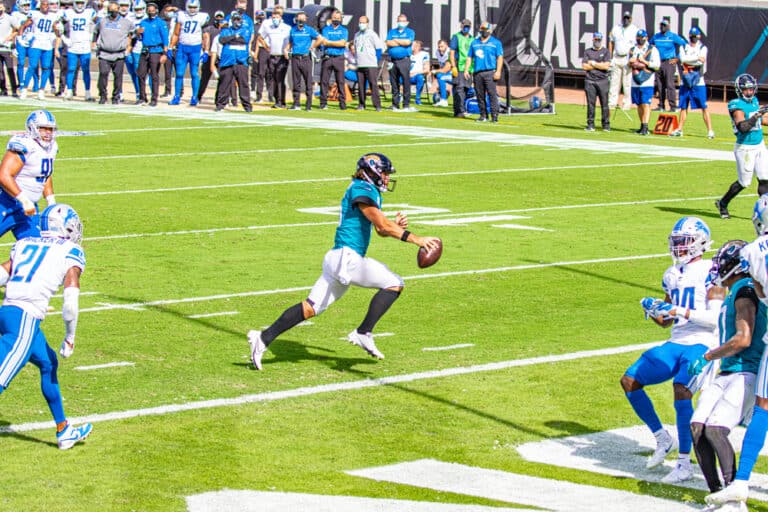Average Lifespan Of An NFL Player (All You Need To Know)
Editorial credit: StacieStauffSmith Photos / Shutterstock.com
While watching the top footballers in the world compete in a physical contest makes for an exciting spectacle, there have been many concerns in recent years regarding the health and wellbeing of NFL players. So, what is the average life expectancy of an NFL player?
While there are varying studies that provide different ages, the consensus is that the average life expectancy of an NFL player is between 53 and 59 years of age. Although the exact age is up for dispute, studies suggest a higher life expectancy than the general population.
To better understand the risks of playing for the NFL and life expectancy, we will explore numerous medical studies below in greater detail:
What Is The Average Life Expectancy Of An NFL Player?
The average life expectancy of a professional NFL player is low at between 53 and 59 years, depending on numerous factors such as:
- Games played,
- Family health history,
- Ethnic groups,
- Position played,
- Post-retirement lifestyle.
Do More NFL Games Put Players At Risk Of Low Life Expectancy?
A study published by JAMA in 2018 found that, on average, career NFL players had a 38% higher risk of dying younger than football players that played in fewer games and in lower divisions (such as amateur clubs or college-level football.)
The leading theory surrounding lower life expectancy is that career NFL players are exposed to more severe head trauma over more prolonged periods when compared to football players in the lower leagues.
Prolonged head trauma increases one’s risk of developing chronic traumatic encephalopathy (CTE.) CTE is a neurological disease that contributes to early set dementia and Alzheimer’s symptoms, which include, but is not limited to:
- Memory loss,
- Confusion,
- Depression,
- Irritability,
- Reduced cognitive functioning,
- Rage,
- Suicidal behavior.
However, while there are studies to suggest repeated head trauma due to increased game type may be a reason for the decreased life expectancy of NFL players, there is no conclusive evidence to suggest a perfect correlation.
In conclusion, not only is 38% a large enough number to raise genuine concerns about NFL football versus lower league football, but the sample group needs to be expanded and studied over several years before an accurate risk analysis can be formulated.
Do Different NFL Positions Have Different Life Expectancies?
While NFL is reserved for only the most elite athletes, the different positions expect and require different skill sets and playstyles. Therefore, depending on the position one plays in American football will determine everything from their diet and exercise routines to their role on the field and the level of physical contact they will be exposed to.
For example, kickers and quarterbacks are technical positions focusing on a player’s fine motor skills and strategic thinking. Therefore, these positions have higher than average career lengths and are deliberately protected/limited in their exposure to physical contact. Thus, they seldom have other NFL players’ size, strength, agility, and speed.
In comparison, NFL players that play defense (like linebackers) are expected to make numerous tackles in a single game. Therefore, they need to have elite power athletes’ build, size, and strength to counter the offensive attack of equally capable opposition players.
While repeated head and body trauma puts certain positions at greater risk of severe injury and reduced life expectancy, the physical makeup expected of certain NFL positions has been shown to be detrimental to a player’s long-term health.
A study by Scripps Howard News Service examined 3 850 NFL players that have died in the past century. The study found that most of the 130 players that died since 1955 were some of the heaviest athletes in American football.
Medical findings showed that of the 130 players, 1/5th died of heart disease, while over half were deemed medically obese. Modern trends would support the risk of ongoing obesity and heart diseases, as more than 500 NFL players in 2006 weighed over 300 pounds! (Hence linebackers have a 52 percent greater chance of dying from heart disease than the American populace.)
Further results from the Scripps Howard News Service worth exploring are as follows:
Approximately 28% of NFL players over the last century qualified as obese before 50 years of age, while another 13% were classified as overweight.
Since 1955 (as of the 2006 study), one out of every 69 NFL players are dead.
Heart disease contributed to 22% of deaths as opposed to 19% who died from suicide or homicide (with 27% of those who died from heart disease being classified as obese.)
Only 10% of NFL players in the 1900s and 1910s were classified as obese versus over 50% of present players who are classified as obese (whereby the average weight of players in the NFL has increased by 10% since 1985!)
In conclusion, while physicality is essential, the recent obsession with high weight classes for certain positions in the modern NFL may place certain players at risk of decreased life expectancy post-retirement.

NFL Life Expectancy Vs. General Population
Although plenty of evidence suggests that the lifestyles, training regimes, physical demands, and the brutal nature of American football may contribute to decreased life expectancy compared to the general populace, some studies suggest the inverse be true.
Following the controversy surrounding player health, the NFL embarked on a study in 1994 in an attempt to refute claims that NFL athletes were at greater risk of early death than the general populace.
While the results of the study are disputed and continue to be challenged as more data is gathered and evaluated, the study suggested that NFL players live longer than the average male American of the same socio-economic background and ethnic group (note: neurological trauma and diseases did not form part of the study.)
Examining the medical records of 3 439 retired NFL players from 1959 to 1988, the study uncovered the following information/data points:
NFL players lived longer than the general populace of American males. Namely, of the 3 3439 retired players, 334 were deceased (while a sample group from the general male populace would anticipate results of 625 deaths.)
NFL players had lower than average cancer rates compared to the general populace (with 85 players having died from cancer-related illnesses versus 146 cancer-related deaths in the general populace.)
NFL players with a BMI of 30 or above (namely, players that were classified as obese) were twice as likely to die from heart disease compared to other players.
Because of their higher-than-average BMI scores, defensive linemen had a 42% higher risk of dying from heart disease compared to the general public (41 defensive linemen died from heart disease compared to 29 deaths in the general populace.)
A leading theory for why NFL players live longer than the general populace, despite the physical demands and risks associated with contact sport, is that:
NFL players have low levels of smoking,
Improved muscle mass and fitness levels compared to the general population,
Improved diet and exercise routines compared to the general population.
NFL Life Expectancy Vs. Other Athletes
While the above study uncovered some vital information regarding the role of fitness, dieting, muscle mass, and BMI percentage in improving life expectancy; many experts believe comparing professional athletes with the general population is a fruitless exercise that does little to compare the advantages/disadvantages of playing American football versus other sports.
A study by our World in Data in 2019 compared the life expectancy of different sports compared to the general population, thus showing a correlation between sports as “general fitness” and its benefits:
- Tennis: 80.4 years of age (7.8 years longer than the general global population)
- Rugby union: 79.1 years of age (6.5 years longer than the general global population)
- NHL hockey: 78.9 years of age (6.3 years longer than the general global population)
- NFL: 78.6 years of age (6.3 years longer than the general global population)
- Golf: 77.8 years of age (5.2 years longer than the general global population)
- Baseball: 77.6 years of age (5 years longer than the general global population)
- Basketball: 77.3 years of age (4.7 years longer than the general global population)
- Cricket: 76.7 years of age (4.1 years longer than the general global population)
- Soccer: 74.6 years of age (2 years longer than the general global population)
- Boxing: 67.7 years of age (4.9 years less than the general global population)
Although the exact data points are often disputed (see an in-depth analysis of MLB versus NFL life expectancy below), there is clear evidence to suggest that with the exception of combat sports like boxing, nearly all sports improve one’s life expectancy.
Why Do NFL Players Live Less Than MLB Players?
A study conducted by Harvard T.H. Chan School of Public Health in 2019 surveyed the medical records of thousands of retired NFL and MLB players between 1979 and 2013. The study found that NFL players live on average seven years less than MLB players, along with the following data points:
The death rate from heart disease was 2.4 times higher in NFL players than MLB players,
The death rate from brain disease was three times higher in NFL players than MLB players.
Most alarming is the deaths from brain diseases, as this is evidence of “the elephant in the room,” which the NFL has sought to deflect for many years (with their studies failing to research the role of head trauma and early death.)
In conclusion, while NFL players may live longer than the general population, their poor results versus equally elite (but safer sports) suggest that athletes may put themselves at elevated risk if they pursue American football over other sports.
Conclusion
In conclusion, while the NFL and medical experts are taking steps to improve the safety and welling of football players, there is some evidence that American football may increase one’s life expectancy compared to other sports.
References
- https://www.comparethemarket.com.au/health-insurance/features/life-expectancy-of-athletes/
- https://www.espn.com/nfl/news/story?id=2313476
- https://edition.cnn.com/2018/02/01/health/nfl-players-early-death-risk-study/index.html
- https://www.sportscasting.com/why-nfl-players-are-dying-at-a-faster-rate-than-other-athletes/
- https://www.quora.com/What-is-the-average-lifespan-of-an-NFL-football-player
- https://www.science.org/content/article/former-football-pros-die-faster-rate-baseball-veterans-and-reasons-are-surprising
- https://www.nytimes.com/2012/05/09/sports/football/nfl-players-live-longer-than-men-in-general-population-study-says.html







